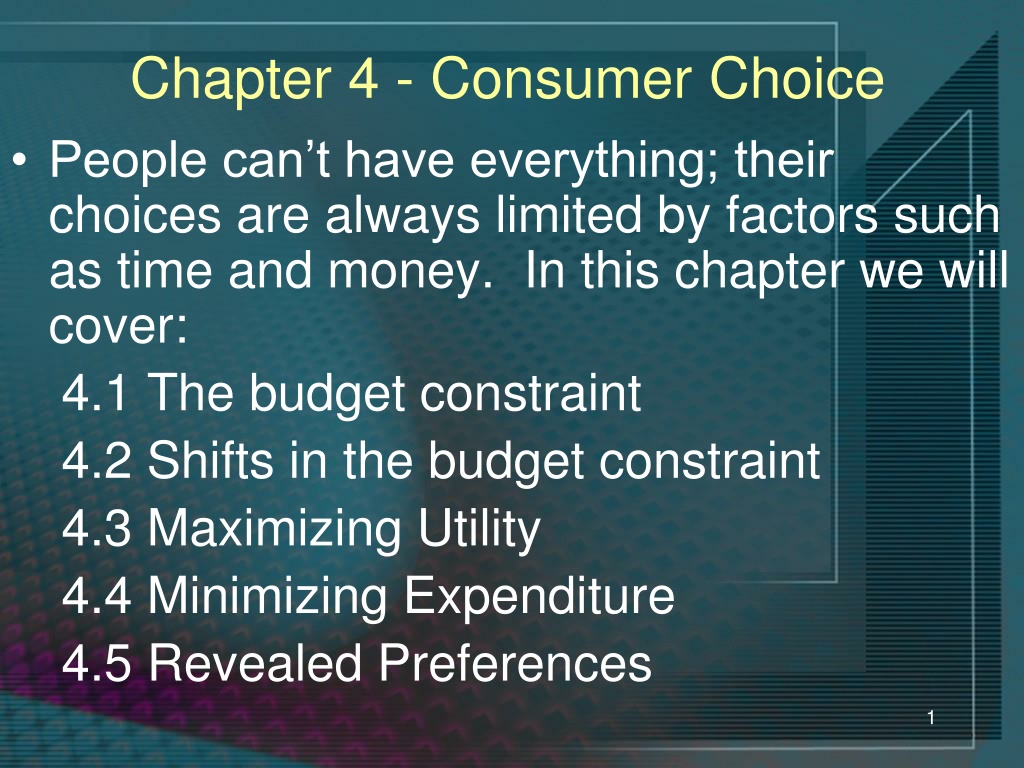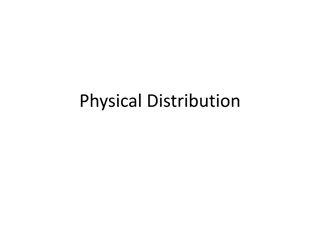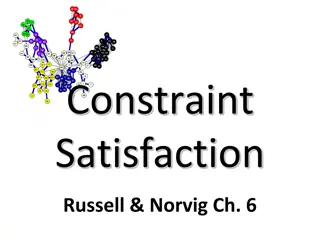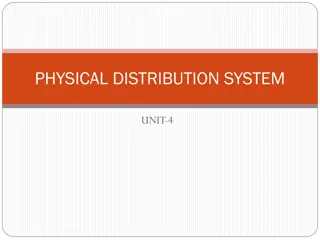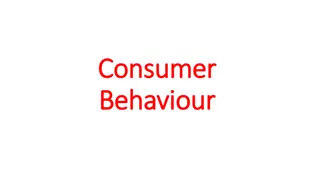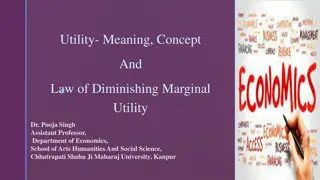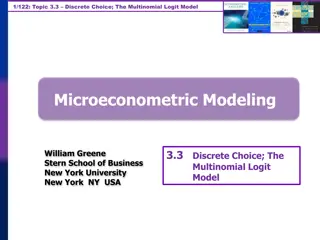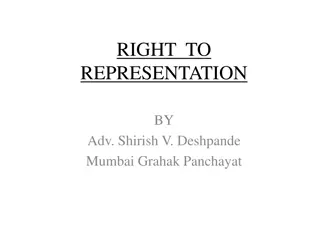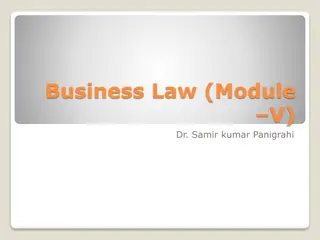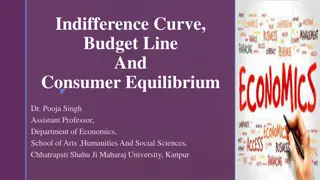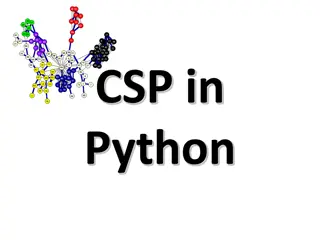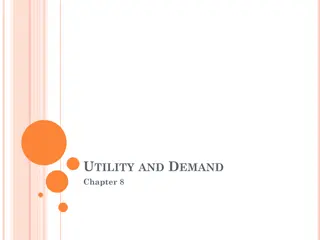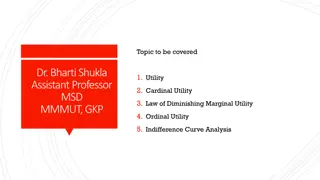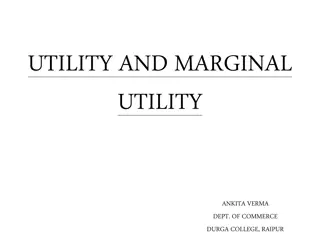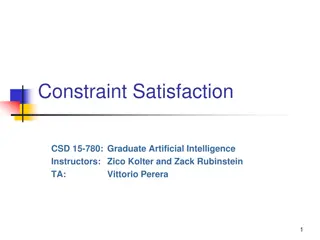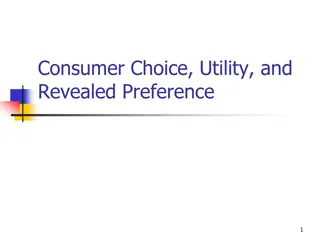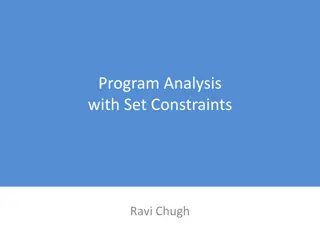Understanding Consumer Choice: Budget Constraint & Utility Maximization
Explore how individuals make choices based on budget constraints and maximize utility through shifts in the budget line. Learn about affordable baskets, budget sets, and the impact of income and prices on consumer decisions.
Download Presentation

Please find below an Image/Link to download the presentation.
The content on the website is provided AS IS for your information and personal use only. It may not be sold, licensed, or shared on other websites without obtaining consent from the author. Download presentation by click this link. If you encounter any issues during the download, it is possible that the publisher has removed the file from their server.
E N D
Presentation Transcript
Chapter 4 - Consumer Choice People can t have everything; their choices are always limited by factors such as time and money. In this chapter we will cover: 4.1 The budget constraint 4.2 Shifts in the budget constraint 4.3 Maximizing Utility 4.4 Minimizing Expenditure 4.5 Revealed Preferences 1
4.1 The Budget Constraint If an individual only consumes 2 goods or services (x and y), their consumption is affected by 3 exogenous variables: The price of x The price of y Income 2
The Budget Constraint Assume only two goods available: x and y Price of x = Px Price of y = Py Total expenditure on basket (x,y): Pxx + Pyy The Basket is Affordable if total expenditure does not exceed total Income: Pxx + Pyy I Income = I 3
Definitions The set of baskets that are affordable is the consumer s BUDGET SET The BUDGET CONSTRAINT defines the set of baskets that the consumer may purchase given the income available: Pxx+Pyy=I The graphable BUDGET LINE is the set of baskets that are just affordable: y=I/Py-(Px/Py)x 4
Example Two goods available: x and y I = $10 Px = $1 Py = $2 Budget line: 1x + 2y = 10 BL1 Or y = 5 x/2 5
Y The Budget Line A y=5-1/2x; 10=2y+x I/PY= 5 -PX/PY = -1/2 B X I/PX = 10 6
Point A: one only consumes y Point B: one only consumes x. Point D: consumes a mixture Point C: consumes a mixture while not spending the entire budget Point E: unobtainable unless prices or income change Y A I/PY= 5 E D C B X I/PX = 10 7
4.2 Shifts in the Budget Constraint The budget line will change if any of its components change: Income (shift of the budget line) Prices of x and/or y (rotation of the budget line) 8
Shift of a budget line Income Increase Y If Income increases, people have more money to spend on both goods The budget line will shift out 6 5 y = 6 - x/2; 12=2y+x y=5-1/2x; 10=2y+x 10 12 X 9
Rotation of a Budget Line If the price of Y rises, the budget line gets flatter and the vertical intercept shifts down (as seen here) Y I = $10 PX = $1 PY = $3 If the price of Y falls, the budget line gets steeper and the vertical intercept shifts up 5 y=5-1/2x; 10=2y+x 3.33 y = 3.33 - x/3 10 10 X
4.3 Maximizing Utility Subject to a Budget Constraint Consumers cannot have everything; they can only purchase what their budget will allow A consumer s budget will allow for many different bundles of goods Each bundle will give a different utility A rational consumer will purchase the bundle that maximizes their utility 11
Maximizing Utility Y Point A: affordable, doesn t maximize utility Point B: unaffordable Point C: affordable (with income left over) but doesn t maximize utility Point D: affordable, maximizes utility BL D B C IC2 A IC1 X 0 12
Maximizing Utility Subject to a Budget Constraint x U y x + . . max , ( ( , ) y ) t s P x P y I x y Maximize utility (which depends on x and y) by choosing x and y . Subject to the constraint that the amount you spend on X and Y must not exceed income (Generally, people spend all their income, so less than or equal to becomes equal to) 13
Maximizing Utility Subject to a Budget Constraint x U y x + . . max , ( ( , ) y ) t s P x P y I x y Exogenous variables: Px, Py and Income Endogenous variables: x and y (chosen) and Utility (outcome) 14
Maximizing Utility M Max U(exercise, movie) given Pexercise=$10 Pmovie=$20, Income=$100 (s.t. Pee+PmM=$100) BL=5-1/2E 5 D: M=3, E=4 3 C IC2 A IC1 E 0 10 4 15
Tangency Recall that : = Slope of the budget = line / P P x y = Slope of the IC / MRS MU MU , x y x y Since the IC tangent t P MU is MU the o MU BL, MU y = = = or x x x MRS , x y P P P x y y y 16
Interior Optimum A basket is an INTERIOR OPTIMUMif positive amounts of all goods are purchased and the indifference curve is tangent to the budget line Note for more than 2 goods: MU MU = MU y = x z P P P x y z 17
Optimization Steps 1) Derive the BUDGET LINE 2) Calculate the point of tangency 3) Use (1) and (2) to solve for the maximizing point 4) Find the Optimum (if possible) and conclude. 18
Maximization Example Vincent enjoys two things: skittles (s) and bubble gum (b). MUs=2b and MUb=3s. A pack of skittles costs $2 while bubble gum costs $1. If Fingers has $20, what should he to do maximize his utility? 19
Optimization Steps 1) PsS+PbB=I 2S+B=20 2) MUs/MUb=Ps/Pb 2B/3S=2/1 2B=6S B=3S 20
Optimization Steps 3) 2S+B=20 2S+3S=20 5S=20 S=4 B=3S B=3(4)=12 21
Optimization Steps 4) Vincent buys 12 bubble gum and 4 packs of skittles in order to maximize his utility. Optional Budget Check: 2S+B=20 2(4)+12=20 20=20 22
Corner Solutions Interior Optimums occur when positive amounts of both goods are consumed to maximize utility Not everyone will maximize utility by consuming both goods: Not everyone buys a Porsche Not everyone values ballet shoes highly When utility is maximized and one good is not consumed, a Corner Solution exists 23
Corner Solutions Porsches Point A consumes positive amounts of both goods, but does not maximize utility Point B maximizes utility while consuming only 1 good. IC1 IC2 BL A B Food 0 24
Corner Solution Example 1) Solve for equilibrium as normal using the tangency condition: MUx/Px=MUy/Py 2) If either good is negative, zero of that good is consumed. (Unless negatives are valid) 3) Recalculate the basket that maximizes utility (using budget constraint). 25
Example Two goods available: Siamese Cats and Dachund Dogs: I = $200 Pc = $100 Pd = $50 Utility is such that: MUc=d MUd=5+c 26
Optimization Steps 1) Pcc+Pdd=I 100c+50d=200 2) MUc/MUd=Pc/Pd d/(5+c)=100/50 50d=500+100c d=10+2c 27
Optimization Steps 3) 100c+50d=200 100c+50(10+2c)=200 200c=-300 c=-3/2, therefore c=0 100(0)+50d=200 d=4 28
Optimization Steps 4) Buying 4 dogs and no cats will maximize your utility: Optional Budget Check: 100c+50d=200 100(0)+50(4)=200 200=200 29
Perfect Compliments In the case of perfect compliments,utility is maximized when goods are consumed in a set ratio, which simplifies our calculations: Example 1: A toy car needs one body and 4 wheels. More than 4 wheels per body is useless More than 1 body per 4 wheels is useless. Therefore: wheels = 4 (body) 30
Perfect Compliments Example 2: Let U(X,Y) = min(X,Y). Let I = $1000, Px = $50 and PY = $200. What is the optimal consumption basket? We know that to maximize utility x=y therefore: 50x+200y=1000 50x+200x=1000 4=x=y 31
U= min(X,Y). U= min(4,4) =4 Utility is maximized at 4 when x and y are equal to 4. Budget line: Y = $5 - X/4 32
4.4 Minimizing Expenditure Thus far, we have considered utility maximization: -Given one s budget constraint, maximize utility (ie: buying the best lunch affordable) Sometimes one wishes to achieve a level of utility for the least cost possible cost minimization -Given one s required utility, what is the least one can spend? (ie: buying the cheapest lunch that will fill you up) 33
Minimization Steps 1) Calculate the point of tangency (as per maximization) 2) Use the point of tangency and the UTILITY constraint to solve for the minimizing x and y 3) Calculate expenditure and conclude. 34
Minimization Example Vincent Hawaii McGiny is a cheap mobster who enjoys the ham and pinapples on his Hawaiian pizzas. Every dinner he aims to achieve a utility of 18 by eating a mini pizza which gives him utility of U=ham*pineapple. (MUh=p, MUp=h) If a slice of ham costs 10 cents and a piece of pineapple costs 20 cents, minimize Hawaii s toping expenditure. 35
Minimization Steps 1) MUh/MUp=Ph/Pp p/h=10/20 20p=10h 2p=h 36
Minimization Steps 2) U=hp 18=2p(p) 9=p2 3=p U=hp 18=h3 6=h 37
Minimization Steps 3) I=Phh+PpP I=0.1(6)+0.2(3) I=1.20 Hawaii s minimum toping expenditure for a mini pizza is $1.20 if he wants a utility of 18. Optional Check: U=ph 18=3(6) 18=18 38
Optimization Comparison Utility Maximization Given prices and utility formulas Given EXPENDITURE Solve tangency condition Substitute into budget constraint Solve for UTILITY Expend. Minimization Given prices and utility formulas Given UTILITY Solve tangency condition Substitute into utility formula Solve for EXPENDITURE 39
Composite Goods In reality, people consume more than one good Economists often want to study one good by graphing that good on the x axis and ALL other goods on the y axis The good on the Y axis is a COMPOSITE GOOD with default price Py=1 40
Composite Good 300 Composite goods allow an economist to study choices revolving around 1 good IC1 A 1 1.5 0 Lava Lamps 41
Composite Goods Application Coupons vs. Cash Often governments consider equilibrium consumption of goods (such as essentials food etc) to be less than optimal Governments then have 2 main options to increase consumption of these goods: vouchers/coupons or cash subsidies Cash subsidies are administratively easier but may not be optimal .. 42
Composite good, units Example: Consider a situation where an individual consumes Fa food, yet the government considers the minimum food an individual needs as FMin I A Food (units) FA FMin I/Ph 43
Composite good, units One option is to offer a cash subsidy to increase food consumption. However, some consumers will spend some of this cash subsidy on other goods (ie: drugs) I+S B I A Food (units) FA FMin I/Ph (I+S)/Ph 44
Composite good, units In order to limit the increase in composite goods, the government can issue food vouchers instead, resulting in the new yellow kinked budget curve I+S I+V B I A C Food (units) FA FMin I/Ph (I+V)/Ph (I+S)/Ph 45
Composite good, units Note: A Kinked budget line due to a voucher often offers less total utility than a cash subsidy equal to the voucher I+V D C Food (units) FA FMin (I+V)/Ph 46
Composite Goods Application Joining a Club Often consumers have the option of joining a club in order to save on goods purchased Ie) Book or CD club Ie) Chapters Rewards, CostCo, etc. While some consumers will benefit from joining the club, others will not 47
Composite Good Originally, a consumer buys 10 CDs at $20 per CD before joining the club 300 IC1 A 10 15 0 CDs (number) 48
Composite Good Joining the club requires a membership fee of $100, which shifts in the budget line. At the same time however, CD s now cost $10 each, shifting the BL s x- intercept as shown. 300 200 IC1 This consumer benefits from joining the club IC2 A B 10 15 20 0 CDs (number) 49
Composite Good Not every consumer will benefit from joining the club 300 A 200 IC1 B IC2 15 20 0 CDs (number) 50
